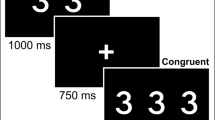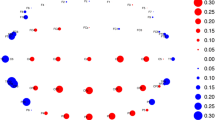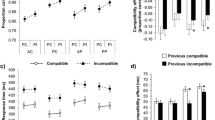Abstract
Rationale
The possibility that moderate blood alcohol concentrations (BACs) may impair cognitive processes before disturbing motor functions has raised concern about the safety of BACs ≤80 mg/100 ml. Reaction time (RT) to the presentation of a stimulus or to the omission of a regularly occurring stimulus has been fractionated into independent premotor (cognitive) and motor (movement) components. It has been suggested that cognitive processes may be impaired at lower BACs than are motor processes, but the effects of moderate rising and declining BACs on these component RT measures have not been investigated.
Objectives
An omitted stimulus RT task was used to test the hypothesis that moderate rising BACs impair (slow) premotor RT (PMRT) when motor RT (MRT) remains unaffected. The task included visual, auditory, and tactile stimuli to explore differences in sensory sensitivity to alcohol.
Methods
Thirty male social drinkers were randomly assigned to three groups (n=10) that received 0.62 g/kg alcohol, 0.8 g/kg alcohol, or a placebo (0 g/kg). All participants performed the task three times: baseline and during rising and declining BACs.
Results
Comparisons of the alcohol and placebo groups showed rising BACs slowed PMRT and had no detectable effect on MRT. Impairment in visual PMRT occurred under both alcohol doses. Auditory PMRT was impaired only under the 0.8 g/kg dose, and tactile PMRT was unaffected.
Conclusions
Cognitive functions are impaired by moderate increasing BACs that do not affect motor movement, and the tactile sensory system may be relatively insensitive to this impairment.


Similar content being viewed by others
References
Babor TF, de la Fuente JR, Saunders J, Grant M (1992) AUDIT: The Alcohol Use Disorders Identification Test. Guidelines for use in primary health care. World Health Organization, Geneva
Barthélémy S, Boulinguez P (2002) Orienting visuospatial attention generates manual reaction time asymmetries in target detection and pointing. Behav Brain Res 133:109–116
Botwinick J, Thompson LW (1966) Premotor and motor components of RT. J Exp Psychol 71:9–15
Bullock TH, Karamürsel S, Achimowicz JZ, McClune MC, Başar-Eroglu C (1994) Dynamic properties of human visual evoked and omitted stimulus potentials. Electroencephalogr Clin Neurophysiol 91:42–53
Fillmore M, Vogel-Sprott M (1994) Psychomotor performance under alcohol and under caffeine: expectancy and pharmacological effects. Exp Clin Psychopharmacol 2:319–327
Fillmore M, Vogel-Sprott M (1995) Expectancies about alcohol-induced motor impairment predict individual differences in responses to alcohol and placebo. J Stud Alcohol 56:90–98
Gustafson R (1986a) Effect of moderate doses of alcohol on simple auditory reaction time in a vigilance setting. Percept Mot Skills 62:683–690
Gustafson R (1986b) Alcohol and vigilance performance: effect of small doses of alcohol on simple visual reaction time. Percept Mot Skills 62:951–955
Hellige JB (1993) Hemispheric asymmetry: what’s right and what’s left. In: Kosslyn SM (ed) Perspectives in cognitive neuroscience. Harvard University Press, Cambridge, MA, pp 10–17
Hernández OH, Ramón F, Bullock TH (1999) Expectation in invertebrates: crayfish have “omitted stimulus potentials” Proceedings of the sixth joint symposium on neural computation, vol. 9. University of California Press, San Diego, pp 50–56
Hernández OH, Huchín-Ramirez TC, Vogel-Sprott M (2005) Behaviorally fractionated reaction time to an omitted stimulus: tests with visual, auditory and tactile stimuli. Percept Mot Skills 100:1066–1080
Holloway FA (1995) Low-dose alcohol effects on human behavior and performance. Alcohol Drugs Driv 11:39–56
Iacoboni M, Zaidel E (1999) The crossed–uncrossed difference in simple reaction times to lateralized auditory stimuli is not a measure of interhemispheric transmission time: evidence from the split brain. Exp Brain Res 128:421–424
Ito M (1997) Fractionated reaction time as a function of magnitude of force in simple and choice conditions. Percept Mot Skills 85:435–444
Kalant H, LeBlanc AE, Gibbins RJ (1971) Tolerance to, and dependence on, some non-opiate psychotropic drugs. Pharmacol Rev 23:135–191
Karamürsel S, Bullock TH (2000) Human auditory fast and slow omitted stimulus potential and steady-state responses. Int J Neurosci 100:1–20
Liguori A, D’Agostino RB Jr, Dworkin SI, Edwards D, Robinson JH (1999) Alcohol effects on mood, equilibrium and simulated driving. Alcohol Clin Exp Res 23:815–821
Mitchell M (1985) Alcohol-induced impairment of central nervous system function: behavioral skills involved in driving. J Stud Alcohol Suppl 10:109–116
Moskowitz H (1984) Attention tasks as skills performance measure of drug effects. Br J Clin Pharmacol 18:51S–61S
Ramón F, Hernández OH, Bullock TH (2001) Event-related potentials in an invertebrate: crayfish emit “omitted stimulus potentials”. J Exp Biol 204:4291–4300
Raynor AJ (1998) Fractionated reflex and reaction time in children with developmental coordination disorder. Motor Control 2:114–124
Simmons RW, Wass T, Thomas JD, Riley EP (2002) Fractionated simple and choice reaction time in children with prenatal exposure to alcohol. Alcohol Clin Exp Res 26:1412–1419
Van Selst M, Jolicoeur P (1994) A solution to the effect of sample size on outlier elimination. Q J Exp Psychol 47:631–650
Vogel-Sprott M, Fillmore MT (1993) Impairment and recovery under repeated doses of alcohol: effects of response-outcomes. Pharmacol Biochem Behav 45:59–63
Welford AT (1952) The “psychological refractory period” and the timing of high speed performance: a review and a theory. Br J Psychol 43:2–19
Zack M (1999) Reinforcement of a behavioral standard modifies individual differences under alcohol. J Stud Alcohol 60:675–684
Acknowledgements
This research was supported in part by a grant to the first author from Consejo Nacional de Ciencia y Tecnología (CONACYT-J200.685/2004) and by the Universidad Autónoma de Campeche, México.
Author information
Authors and Affiliations
Corresponding author
Rights and permissions
About this article
Cite this article
Hernández, O.H., Vogel-Sprott, M., Huchín-Ramirez, T.C. et al. Acute dose of alcohol affects cognitive components of reaction time to an omitted stimulus: differences among sensory systems. Psychopharmacology 184, 75–81 (2006). https://doi.org/10.1007/s00213-005-0237-7
Received:
Accepted:
Published:
Issue Date:
DOI: https://doi.org/10.1007/s00213-005-0237-7




